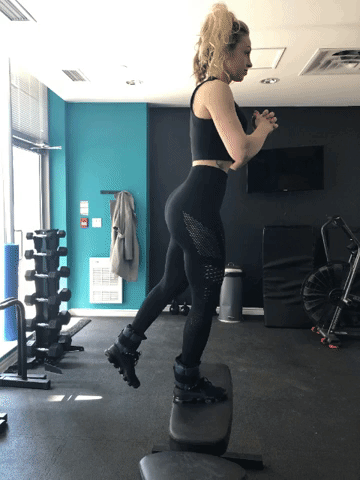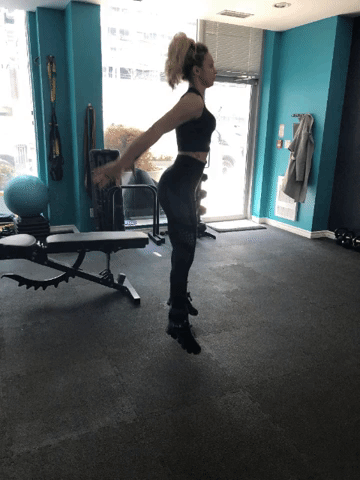The Pros and Cons of Ankle Weights
Table of Contents
What Are Ankle Weights?
Ankle weights are “weights” that you slip onto your ankles before doing an exercise. Its primary goal is to overall increase strength and improve endurance. Adding additional weight onto your base forces your body to exert and produce more force than what you’re accustomed to, eventually increasing your endurance and building your overall stamina. Moreover, ankle weights are also used to increase overall musculature and mass in your glutes, quadriceps and calves.
Should Ankle Weights Be a Part of Your Next Workout?
When you’re doing your training routine and you want to easily raise the stakes, adding some wearable weights to your routine is probably one of the top ideas to increase overall body strength and calorie burn. It’s very basic; slip them on and carry on with your workout, whether you’re walking, jogging, running, or jumping.
You simply add some weights, which makes your muscles work harder and adds changes to the mechanics of your gait. This is what makes this exercise equipment highly popular, being incorporated into numerous exercises throughout the years, especially in aerobics.
Before you go out and buy ankle weights, did you know that using them incorrectly or recklessly can do more harm than good?
The Whats and Hows of Ankle Weights
Before we dive deep into this... it’s important we know everything there is about ankle weights.
Are Ankle Weights Good or Bad for You?
If ankle weights used the right way, they're good for you. If you understand how to use them, what exercises are safe, when to stop exercising with them, then you're in the clear. However, If ankle weights used the wrong way, they will be bad for you. Make sure you don't have any existing ankle or knee injuries. As a result, this can worsen the condition. If you are unsure of this, consult a physician. In addition, if you're unsure of what exercises to do and how to go about using ankle weights consult a personal trainer with proper knowledge.
Benefits of Ankle Weights
The benefits of ankle weights is that it’s an accessible way to add load to exercises where you elevate your leg. Since the ankle weights are securely attached to your ankles, it eliminates the clumsiness of trying to hold a dumbbell or other standard gym equipment with your lower limbs. They can also be used to make cardio exercises more challenging due to the added weight.
With proper use, ankle weights can do a lot to enhance workouts. Here are other benefits of ankle weights:
Better Endurance
As previously mentioned, when used properly, ankle weights can help build your overall endurance. This is because the extra force you exert helps increase your stamina, which in turn helps your cardiovascular and pulmonary health.
Tones Your Legs
If doing leg raises without any resistance already does a lot to shape your legs then imagine what your legs could look like with incorporating weights. In fact, it is recommended to add weight resistance when it comes to toning your legs, as it proves to be far more effective than simply doing more reps. Of course, with any workout routine, variation is recommended and needed.
More Versatility
Ankle weights can also be helpful in adding variety to your routine. You can also add them to your stationary exercises, such as multi-plane leg raises.
More Burned Calories
Ankle weights can also help you burn a few hundred calories. This is because applying more force results in more energy expenditure; which results in your body burning more calories. Ankle weights are a great way to add progressive overload.
Strengthens Stems
In addition to tone your thighs, wearing weights while working out increases the overall strength of your glutes and hamstrings and calves.
Help in Water Workouts
Although it’s rather uncommon, many athlete’s use ankle weights while swimming. A big perk to this is that it doesn’t cause any joint issues. In fact, using ankle weights while swimming can actually strengthen your knee and ankle joints.
Extra Resistance to Abdominal Workouts
Believe it or not, ankle weights can help take your abdominal workouts to the next level. Especially since the abs are a difficult area to train and can be best targeted via compound movements. Ensure to maintain a pelvic tilt the whole way through. A great exercise to do with ankle weights and one of our favorites is abdominal leg raises. Give it a go!
Disadvantages of Ankle Weights
We’ve highlighted most of the benefits of using ankle weights. However, it’s also important to address the disadvantages. Ankle weights are a tool, and excessive use of these can cause serious problems. Because of this, it’s recommended to use them sparingly and/or moderately. According to Dr. Anthony Lee, Assistant Professor of Orthopedics and Director of Primary Care Sports Medicine states that “ankle weights can easily cause joint stress (as opposed to muscle-building) if you use them all the time.
Another reason is that your muscles, tendons, and joints, need rest once in a while. Adding weight consistently can overload the joints. A method to training around this would be to simply increase your reps and/or speed and put the weights aside. When it comes to aerobic and cardiovascular exercise, ankle weights also tend to be less effective than stair-climbing or uphill-walking. Not to mention that the latter provides a bigger calorie burn.
For anyone looking to add variation or a method to increase intensity in their usual monotonous exercise routine, the ankle weights provide a quick and easy solution. It’s cost-effective, versatile, and can be utilized in a whole myriad of exercises. As a matter of fact, you can target all major muscle groups using ankle weights, given you know how to properly use it, and you do so in moderation.
The bottom line is, it’s a great tool. However, too much of a good thing can be bad, and in this case, relying on temporary added resistance and strength isn’t going to give you any good and long lasting results. So add variation, keep everything in moderation, and be safe!
Top 3 Ankle Weight Exercises
Ankle Weight Step Up
The ankle weight step-up is very similar to the traditional step-up exercise. The only difference is adding ankle weights to your routine. For beginners, I recommend starting with single-leg repetitions rather than alternating legs. Position your right leg on the bench or step, lift yourself up, then come back down. Perform five repetitions, then switch sides. For advanced users, you can alternate legs while keeping proper form. Some individuals also add additional weights for more intensity as they progress.
Ankle Weight Knee Up
Another great exercise with ankle weights is the knee raise. After securing the weights on your ankles, simply raise one knee while maintaining control. Typically, people hold the position for one to two seconds before lowering the leg back down. You can alternate legs for up to 10 repetitions. For an added challenge, you can raise your knee and hold the position for 10 seconds, which primarily engages the hip flexors.
Ankle Weight Squat Jump
Lastly, the ankle weight squat jump is another effective exercise that increases the intensity of your squats. Perform this exercise similarly to a traditional squat jump: slightly bend your knees, keep your chest up, engage your core, and perform a controlled micro-jump rather than a full jump. Pay close attention to your form and brace your core to prevent lower back pain during this exercise.
These exercises can effectively enhance strength and stability when done correctly and progressively.
Adjustable Ankle Weights: Benefits, and How to Use Them Effectively
You can purchase adjustable ankle weights that allow you to add or subtract a load. These types of adjustable ankle weights have pouches that allow you to change the weight by around half a pound for each pouch. Adjustable ankle weights also allow you to adjust the strap around the ankle, to ensure that the weight fits comfortably around the ankle and will not fall off.
Adjustable ankle weights are great for those who want to gradually work their way up to a certain weight, or who are rehabilitating injuries. You can purchase adjustable ankle weights online on Amazon or through other equipment retailers.
Ankle Weights Workout: Effective Exercises for Strength and Endurance
There are many ways that you can involve ankle weights in your workouts. An example of a full body ankle weight workout can include,
Superman with ankle weight
Arm Circles with ankle weight
Leg Raises with ankle weight (both side and front)
Bicycle Kick with ankle weight
If you are just starting to use ankle weights, remember to start with a small load! Try 3 sets of 10 reps, and then increase the load, reps or sets as you build endurance.
Leg Workouts with Ankle Weights
There are plenty of leg workouts with ankle weights that you can try. Some examples of exercises with ankle weights that will engage the legs to include,
Leg Raises to the Side
Front Leg Raises
Core Exercises with Ankle Weights
The Use of Ankle Weights When Running or Walking
It is not recommended to run or walk with ankle weights as they can alter your gait pattern if used incorrectly. They can also cause strains in the joint and leg from overuse. A safer option to enhance your running or walking routine is to increase your pace or wear a weighted vest that will distribute the load more evenly across the body.
Ankle Weights for Older Demographics
A study published in the International Journal of Environmental Research and Public Health examined the effects of a three-month ankle weight intervention on older adults. The study concluded that there was a significant increase in lower body strength. Participants experienced increased limb circumference and improved performance in the Chair Stand-30 (CS-30) test. These findings suggest that incorporating ankle weights can be an effective strategy for strengthening the lower body in older populations.
Frequently Asked Questions About Ankle Weights
Safety Considerations for Ankle Weights
When using ankle weights, it's essential to prioritize safety to avoid injury. Here are some key considerations:
Start Light: Avoid starting with heavy weights. Using too much weight too soon can strain your muscles and joints, especially if you're not accustomed to it. Begin with a manageable load to allow your body to adapt.
Avoid Prolonged Use: If you're new to ankle weights, limit your usage time. A common mistake people make is going too hard at first—working out for 30 minutes to an hour right away. Instead, start small, with as little as five minutes. Gradually increase the duration over time, for example:
Day 1: Use the weights for five minutes.
Day 2: Rest.
Day 3: Increase to six or seven minutes, and so on.
Progressively building your tolerance helps prevent strain and ensures a smoother adjustment.
Maintain Proper Form: Always focus on proper form during exercises. Many people attempt unusual or unfamiliar movements with ankle weights, leading to muscle pulls or strain. While minor soreness is normal, improper movements can cause injuries. Ensure you understand the exercise technique and listen to your body throughout the workout.
Listen to Your Body: Pay close attention to how your body responds. If you feel unusual pain or discomfort, stop immediately. This approach minimizes the risk of injury and helps you maintain consistency in your workouts.
Alternatives to Ankle Weights
If you don't have ankle weights, consider these alternatives:
Resistance Bands: Resistance bands can mimic some of the benefits of ankle weights and offer versatility for different exercises.
Cable Machines with Ankle Attachments: These machines are a great substitute for targeted lower-body exercises.
While not identical to ankle weights, these options can provide similar benefits and are worth exploring.
Impact on Joint Health
Ankle weights can stress your joints, particularly your knees and hips. To minimize the risk of joint-related injuries:
Progress gradually with weight increases. Avoid starting with heavy weights like 20 or 30 pounds, especially if you're running or doing high-impact exercises.
Older individuals should be particularly cautious with joint stress, while younger users should still prioritize gradual progression and proper form.
If you're unsure about your joint health or ability to handle the weights, consult a fitness expert or medical professional.
Frequency and Duration
For beginners, a gradual approach is key:
Use ankle weights for five minutes initially, then allow a recovery day before increasing duration or intensity.
As your body adapts, you can progressively add time or weight, but always give yourself sufficient rest between sessions to recover.
What Are Leg Weights?
Leg weights are ankle weights that you can wrap around your ankles. They will provide an additional load and are great for enhancing lower body or core workouts. Leg weights are a cost-effective option for those looking to add some resistance to their exercise routine.
How to Use Ankle Weights?
To use ankle weights, simply wrap one weight around each ankle and adjust the strap to fit. The ankle weight should be snug just above the ankle so that it does not fall off during your workout. It does not need to be a tight fit and doing so may restrict blood flow to your foot! Once the ankle weight is secured around the ankle (or wrist) proceed to perform your workout while maintaining the same form that you usually would.
How to Make Ankle Weights?
If you decide that you do not want to purchase ankle weights, you can get creative and make your own at home. To do so, you will need a long sock, rice, beans or sand, and some string and a shoelace.
Fill the sock with either rice, beans or sand. Weigh the sock to ensure that it is the appropriate weight. If you are unsure and have never used an ankle weight before, start with a sock that weighs one pound. Tie the end of the sock so the filling does not spill out. Use the string to divide the sock into sections. This will create a series of small circles in the sock.
Next, use a shoelace to create the strap that runs down the weight. Start by tying the shoelace to one end of the sock, and then creating a knot at each division between the circles as you get down to the other end. The shoelace will act as the strap that you will tie together when the weight is around the ankle.
Are Ankle Weights Bad for Your Knees?
Ankle weights are safe when used properly. If you are experiencing pain in the ankles and the knees, it is not recommended to use ankle weights. However, many people use ankle weights to help the rehabilitation process after knee surgery. Remember to follow the advice of your doctor.
It is not advised to run or walk with ankle weights, as they can produce stress on your joints and potentially alter your gait pattern if used for long periods of time.
What Is a Good Weight for Ankle Weights?
Ankle weights can range from 0.5-20 pounds. If you are just starting out with ankle weights, we recommend beginning with the lowest weight and increasing the load as you become more familiar with the feel of ankle weights and increase your muscular strength.
Do Ankle Weights Actually Work for Building Strength and Endurance?
Yes! Ankle weights absolutely work. Ankle weights are specifically ideal for those who are rehabilitating injuries and those who are looking to tone the legs, add more variety to their workouts and increase endurance. When used correctly, ankle weights are a great asset to a workout. However, when used incorrectly, ankle weights can cause joint stress if used too often.
Is It Recommended to Run With Ankle Weights?
It is not recommended to run with ankle weights as they can easily cause changes in your gait pattern and possibly produce muscular imbalances. Try using a weighted vest instead if you are looking to run with a load.
Can Wrist Weights Be Used in Place of Ankle Weights?
Ankle weights can also be used as wrist weights. They are versatile pieces of equipment that can be adjusted to fit the ankle or the wrist!
What Are the Effects of Using Ankle Weights Before and After Exercise?
After consistently using ankle weights appropriately in your workouts, you will see a change in the body when thinking about how you started before, and where you are after using ankle weights! Document your changes to motivate you and others to keep moving and see how ankle weights can elevate your workouts!
Are Ankle Weights Beneficial for Basketball Training?
Some basketball players will incorporate the use of ankle weights into some of their workouts to help them increase the height of their vertical jump. The use of ankle weights during exercises such as step ups and box jumps will help to develop the muscles in the legs. Remember to start with a low weight, and build your tolerance up from there.
Are Ankle Weights Effective for Workouts and Fitness Goals?
The effective way of using ankle weights is to break them into your routine slowly. If you're planning on using ankle weights, start with 5 mins on the first day, then the following day skip using ankle weights. The third day, resume using the ankle weights and instead of doing 5 mins, to 7 or 10 mins. It is by far the most effective way of using ankle weights.
Ankle weights are effective if utilized in the right way. If used the wrong way, they become ineffective. Walking or running with them is excellent! Just make sure to monitor signs of fatigue or if your ankles start hurting.
Is Walking with Ankle Weights Beneficial?
Even though you burn more calories and can tone your legs with Ankle Weights, it is not recommended to walk with Ankle Weights. As previously mentioned, ankles weights can easily cause joint stress and even muscle strain or overload of the joints.
As well, heavier ankle weights can cause changes to your stride, which can create stress on the back and hips. If you do choose to walk with Ankle Weights as part of a rehabilitative process, make sure they are not heavier than 3-5 pounds.
If you are looking to increase the intensity of your walks, try jogging for short spurts during your walk or simply increase your pace. When walking outdoors, it can be helpful to use landmarks such as lampposts to determine the distance you will increase your pace or jog for.
How Much Weight Should I Use for Ankle Weights?
Ankle weights can range from 0.5-20 pounds. It is a common belief that the heavier the ankle weight, the more strength you will gain, but this is not the case! It is important to select the right weight depending on the exercise you are performing as the incorrect weight can cause injury and muscle strain.
As with any load, we recommend that you start with a lower weight, and then increase. This increase can occur when you have two reps in reserve.
Final Recommendations
Everyone's body is different, and individual tolerance varies. If you're uncertain about how to incorporate ankle weights into your routine:
Consult a professional for personalized advice.
Monitor your progress and adjust accordingly.
Focus on gradual increases and proper form to ensure safe and effective workouts.
By following these guidelines, you can make the most out of ankle weights while minimizing the risk of injury.
We are a participant in the Amazon Services LLC Associates Program, an affiliate advertising program designed to provide a means for us to earn fees by linking to Amazon.com and affiliated sites. When you click on and/or make a purchase through a link to an Amazon affiliate link placed on our website, we may receive a small commission at no additional cost to you.






